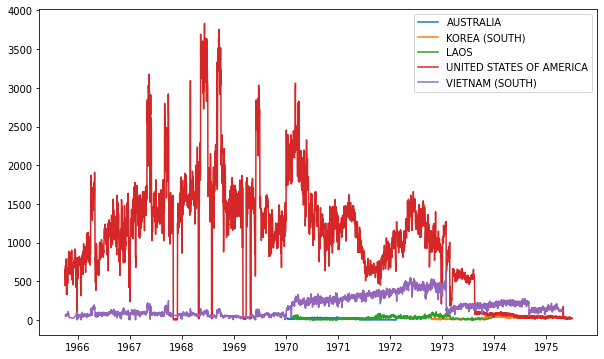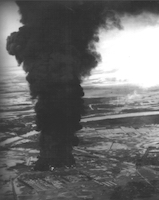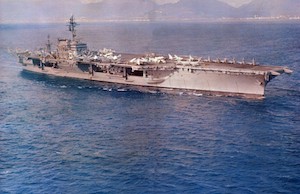Thanks for visiting my GitHub page. This project is about applying data analysis skills using Spark on Vientam War. Please follow interactive instructions to learn more about the project in this README.md file.
Let's setup Spark on Colab environment. Run the cell below!
!pip install pyspark
!pip install -U -q PyDrive
!apt install openjdk-8-jdk-headless -qq
import os
os.environ["JAVA_HOME"] = "/usr/lib/jvm/java-8-openjdk-amd64"Collecting pyspark
Downloading pyspark-3.1.2.tar.gz (212.4 MB)
�[K |████████████████████████████████| 212.4 MB 21 kB/s
�[?25hCollecting py4j==0.10.9
Downloading py4j-0.10.9-py2.py3-none-any.whl (198 kB)
�[K |████████████████████████████████| 198 kB 56.9 MB/s
Lets authenticate a Google Drive client to download the file we will be processing on Spark job.
from pydrive.auth import GoogleAuth
from pydrive.drive import GoogleDrive
from google.colab import auth
from oauth2client.client import GoogleCredentials
# Authenticate and create the PyDrive client
auth.authenticate_user()
gauth = GoogleAuth()
gauth.credentials = GoogleCredentials.get_application_default()
drive = GoogleDrive(gauth)id='1L6pCQkldvdBoaEhRFzL0VnrggEFvqON4'
downloaded = drive.CreateFile({'id': id})
downloaded.GetContentFile('Bombing_Operations.json.gz')
id='14dyBmcTBA32uXPxDbqr0bFDIzGxMTWwl'
downloaded = drive.CreateFile({'id': id})
downloaded.GetContentFile('Aircraft_Glossary.json.gz') If you executed the cells above, you should be able to see the files Bombing_Operations.json.gz and Aircraft_Glossary.json.gz under the "Files" tab on the left panel.
# Let's import the libraries we will need
import pandas as pd
import numpy as np
import matplotlib.pyplot as plt
%matplotlib inline
import pyspark
from pyspark.sql import *
from pyspark.sql.functions import *
from pyspark import SparkContext, SparkConfLet's initialize the Spark context.
# create the session
conf = SparkConf().set("spark.ui.port", "4050")
# create the context
sc = pyspark.SparkContext(conf=conf)
spark = SparkSession.builder.getOrCreate()We can easily check the current version and get the link of the web interface. In the Spark UI, It is easy to monitor the progress of job and debug the performance bottlenecks (if your Colab is running with a local runtime).
sparkSparkSession - in-memory
SparkContext
Spark UI
Version
v3.1.2
Master
local[*]
AppName
pyspark-shellThe cell below will create a ngrok tunnel which will allow us to still check the Spark UI.
!wget https://bin.equinox.io/c/4VmDzA7iaHb/ngrok-stable-linux-amd64.zip
!unzip ngrok-stable-linux-amd64.zip
get_ipython().system_raw('./ngrok http 4050 &')
!curl -s http://localhost:4040/api/tunnels | python3 -c \
"import sys, json; print(json.load(sys.stdin)['tunnels'][0]['public_url'])"--2021-10-06 03:56:26-- https://bin.equinox.io/c/4VmDzA7iaHb/ngrok-stable-linux-amd64.zip
Resolving bin.equinox.io (bin.equinox.io)... 54.161.241.46, 18.205.222.128, 52.202.168.65, ...
Connecting to bin.equinox.io (bin.equinox.io)|54.161.241.46|:443... connected.
HTTP request sent, awaiting response... 200 OK
Length: 13832437 (13M) [application/octet-stream]
Saving to: ‘ngrok-stable-linux-amd64.zip’
ngrok-stable-linux- 100%[===================>] 13.19M 5.40MB/s in 2.4s
2021-10-06 03:56:29 (5.40 MB/s) - ‘ngrok-stable-linux-amd64.zip’ saved [13832437/13832437]
Archive: ngrok-stable-linux-amd64.zip
inflating: ngrok
Traceback (most recent call last):
File "<string>", line 1, in <module>
IndexError: list index out of range
Pres. Johnson: What do you think about this Vietnam thing? I’d like to hear you talk a little bit.
Sen. Russell: Well, frankly, Mr. President, it’s the damn worse mess that I ever saw, and I don’t like to brag and I never have been right many times in my life, but I knew that we were going to get into this sort of mess when we went in there.
May 27, 1964
The Vietnam War, also known as the Second Indochina War, and in Vietnam as the Resistance War Against America or simply the American War, was a conflict that occurred in Vietnam, Laos, and Cambodia from 1 November 1955 to the fall of Saigon on 30 April 1975. It was the second of the Indochina Wars and was officially fought between North Vietnam and the government of South Vietnam.
The dataset describes all the air force operation in during the Vietnam War.
Bombing_Operations Get the dataset here
- AirCraft: Aircraft model (example: EC-47)
- ContryFlyingMission: Country
- MissionDate: Date of the mission
- OperationSupported: Supported War operation (example: Operation Rolling Thunder)
- PeriodOfDay: Day or night
- TakeoffLocation: Take off airport
- TimeOnTarget
- WeaponType
- WeaponsLoadedWeight
Aircraft_Glossary Get the dataset here
- AirCraft: Aircraft model (example: EC-47)
- AirCraftName
- AirCraftType
Dataset Information:
THOR is a painstakingly cultivated database of historic aerial bombings from World War I through Vietnam. THOR has already proven useful in finding unexploded ordnance in Southeast Asia and improving Air Force combat tactics: https://www.kaggle.com/usaf/vietnam-war-bombing-operations
Load the datasets:
Bombing_Operations = spark.read.json("Bombing_Operations.json.gz")
Aircraft_Glossary = spark.read.json("Aircraft_Glossary.json.gz")Check the schema:
Bombing_Operations.printSchema()root
|-- AirCraft: string (nullable = true)
|-- ContryFlyingMission: string (nullable = true)
|-- MissionDate: string (nullable = true)
|-- OperationSupported: string (nullable = true)
|-- PeriodOfDay: string (nullable = true)
|-- TakeoffLocation: string (nullable = true)
|-- TargetCountry: string (nullable = true)
|-- TimeOnTarget: double (nullable = true)
|-- WeaponType: string (nullable = true)
|-- WeaponsLoadedWeight: long (nullable = true)
Aircraft_Glossary.printSchema()root
|-- AirCraft: string (nullable = true)
|-- AirCraftName: string (nullable = true)
|-- AirCraftType: string (nullable = true)
Get a sample with take():
Bombing_Operations.take(3)[Row(AirCraft='EC-47', ContryFlyingMission='UNITED STATES OF AMERICA', MissionDate='1971-06-05', OperationSupported=None, PeriodOfDay='D', TakeoffLocation='TAN SON NHUT', TargetCountry='CAMBODIA', TimeOnTarget=1005.0, WeaponType=None, WeaponsLoadedWeight=0),
Row(AirCraft='EC-47', ContryFlyingMission='UNITED STATES OF AMERICA', MissionDate='1972-12-26', OperationSupported=None, PeriodOfDay='D', TakeoffLocation='NAKHON PHANOM', TargetCountry='SOUTH VIETNAM', TimeOnTarget=530.0, WeaponType=None, WeaponsLoadedWeight=0),
Row(AirCraft='RF-4', ContryFlyingMission='UNITED STATES OF AMERICA', MissionDate='1973-07-28', OperationSupported=None, PeriodOfDay='D', TakeoffLocation='UDORN AB', TargetCountry='LAOS', TimeOnTarget=730.0, WeaponType=None, WeaponsLoadedWeight=0)]
Get a formatted sample with show():
Aircraft_Glossary.show()+--------+--------------------+--------------------+
|AirCraft| AirCraftName| AirCraftType|
+--------+--------------------+--------------------+
| A-1|Douglas A-1 Skyra...| Fighter Jet|
| A-26|Douglas A-26 Invader| Light Bomber|
| A-37|Cessna A-37 Drago...|Light ground-atta...|
| A-4|McDonnell Douglas...| Fighter Jet|
| A-5|North American A-...| Bomber Jet|
| A-6|Grumman A-6 Intruder| Attack Aircraft|
| A-7| LTV A-7 Corsair II| Attack Aircraft|
| AC-119|Fairchild AC-119 ...|Military Transpor...|
| AC-123|Fairchild C-123 P...|Military Transpor...|
| AC-130|Lockheed AC-130 S...|Fixed wing ground...|
| AC-47|Douglas AC-47 Spooky|Ground attack air...|
| AH-1| Bell AH-1 HueyCobra| Helicopter|
| B-1| Rockwell B-1 Lancer|Heavy strategic b...|
| B-52| B-52 Stratofortress| Strategic bomber|
| B-57|Martin B-57 Canberra| Tactical Bomber|
| B-66|Douglas B-66 Dest...| Light Bomber|
| C-1| Grumman C-1A Trader| Transport|
| C-117| C-117D Skytrain| Transport|
| C-119|Fairchild C-119 F...|Military Transpor...|
| C-123|Fairchild C-123 P...|Military Transpor...|
+--------+--------------------+--------------------+
only showing top 20 rows
print("In total there are {0} operations".format(Bombing_Operations.count()))In total there are 4400775 operations
Keywords: Dataframe API, SQL, group by, sort
Let's group the missions by ContryFlyingMission and count how many records exist:
missions_counts = Bombing_Operations.groupBy("ContryFlyingMission")\
.agg(count("*").alias("MissionsCount"))\
.sort(desc("MissionsCount"))
missions_counts.show()+--------------------+-------------+
| ContryFlyingMission|MissionsCount|
+--------------------+-------------+
|UNITED STATES OF ...| 3708997|
| VIETNAM (SOUTH)| 622013|
| LAOS| 32777|
| KOREA (SOUTH)| 24469|
| AUSTRALIA| 12519|
+--------------------+-------------+
In this case I have used the DataFrame API, but I could rewite the groupBy using pure SQL:
Bombing_Operations.registerTempTable("Bombing_Operations")
query = """
SELECT ContryFlyingMission, count(*) as MissionsCount
FROM Bombing_Operations
GROUP BY ContryFlyingMission
ORDER BY MissionsCount DESC
"""
missions_counts = spark.sql(query)
missions_counts.show()+--------------------+-------------+
| ContryFlyingMission|MissionsCount|
+--------------------+-------------+
|UNITED STATES OF ...| 3708997|
| VIETNAM (SOUTH)| 622013|
| LAOS| 32777|
| KOREA (SOUTH)| 24469|
| AUSTRALIA| 12519|
+--------------------+-------------+
The Dataframe is small enough to be moved to Pandas:
missions_count_pd = missions_counts.toPandas()
missions_count_pd.head()| ContryFlyingMission | MissionsCount | |
|---|---|---|
| 0 | UNITED STATES OF AMERICA | 3708997 |
| 1 | VIETNAM (SOUTH) | 622013 |
| 2 | LAOS | 32777 |
| 3 | KOREA (SOUTH) | 24469 |
| 4 | AUSTRALIA | 12519 |
Let's plot a barchart with the number of missions by country:
pl = missions_count_pd.plot(kind="bar",
x="ContryFlyingMission", y="MissionsCount",
figsize=(10, 7), log=True, alpha=0.5, color="olive")
pl.set_xlabel("Country")
pl.set_ylabel("Number of Missions (Log scale)")
pl.set_title("Number of missions by Country")Text(0.5, 1.0, 'Number of missions by Country')
Keywords: group by, parse date, plot
Selecting the relevant columns:
missions_countries = Bombing_Operations.selectExpr(["to_date(MissionDate) as MissionDate", "ContryFlyingMission"])
missions_countriesDataFrame[MissionDate: date, ContryFlyingMission: string]
The filed MissionDate is converted to a Python date object.
Now I can group by MissionDate and ContryFlyingMission to get the count:
missions_by_date = missions_countries\
.groupBy(["MissionDate", "ContryFlyingMission"])\
.agg(count("*").alias("MissionsCount"))\
.sort(asc("MissionDate")).toPandas()
missions_by_date.head().dataframe tbody tr th {
vertical-align: top;
}
.dataframe thead th {
text-align: right;
}
| MissionDate | ContryFlyingMission | MissionsCount | |
|---|---|---|---|
| 0 | 1965-10-01 | UNITED STATES OF AMERICA | 447 |
| 1 | 1965-10-02 | UNITED STATES OF AMERICA | 652 |
| 2 | 1965-10-03 | UNITED STATES OF AMERICA | 608 |
| 3 | 1965-10-04 | UNITED STATES OF AMERICA | 532 |
| 4 | 1965-10-05 | UNITED STATES OF AMERICA | 697 |
Now I can plot the content with a different series for each country:
fig = plt.figure(figsize=(10, 6))
# iterate the different groups to create a different series
for country, missions in missions_by_date.groupby("ContryFlyingMission"):
plt.plot(missions["MissionDate"], missions["MissionsCount"], label=country)
plt.legend(loc='best')<matplotlib.legend.Legend at 0x7f945319c0d0>
Let's observe how South Vietnam increased its missions starting from 1970. The drop in 1973 is motivated by the Paris Peace Accords that took place on January 27th, 1973, to establish peace in Vietnam and end the war.
Keywords: RDD map reduce cache save results
This picture is the Hanoi POL facility (North Vietnam) burning after it was attacked by the U.S. Air Force on 29 June 1966 in the context of the Rolling Thunder operation.
I am interested in discovering what was the most common take-off location during that day.
jun_29_operations = Bombing_Operations.where("MissionDate = '1966-06-29' AND TargetCountry='NORTH VIETNAM'")Which coutries scheduled missions that day?
jun_29_operations.groupBy("ContryFlyingMission").agg(count("*").alias("MissionsCount")).toPandas().dataframe tbody tr th {
vertical-align: top;
}
.dataframe thead th {
text-align: right;
}
| ContryFlyingMission | MissionsCount | |
|---|---|---|
| 0 | VIETNAM (SOUTH) | 6 |
| 1 | UNITED STATES OF AMERICA | 389 |
Most of the operation that day were performed by USA airplanes.
jun_29_operations.take(1)[Row(AirCraft='F-105', ContryFlyingMission='UNITED STATES OF AMERICA', MissionDate='1966-06-29', OperationSupported='STEEL TIGER', PeriodOfDay='D', TakeoffLocation='TAKHLI', TargetCountry='NORTH VIETNAM', TimeOnTarget=310.0, WeaponType='1000LB MK-83', WeaponsLoadedWeight=-1)]
I am specifying to cache the content in memory:
jun_29_operations.cache()DataFrame[AirCraft: string, ContryFlyingMission: string, MissionDate: string, OperationSupported: string, PeriodOfDay: string, TakeoffLocation: string, TargetCountry: string, TimeOnTarget: double, WeaponType: string, WeaponsLoadedWeight: bigint]
Now let's count the number of rows and move the content to the cache:
%time jun_29_operations.count()CPU times: user 38.5 ms, sys: 7.27 ms, total: 45.8 ms
Wall time: 8 s
395
It appears that he second time content is cached and the operation is much faster:
%time jun_29_operations.count()CPU times: user 3.9 ms, sys: 13 µs, total: 3.92 ms
Wall time: 79.7 ms
395
Save the results on a file...
jun_29_operations.write.mode('overwrite').json("jun_29_operations.json")... and reading from the file:
jun_29_operations = spark.read.json("jun_29_operations.json")Using the simple DataFrame API...
TakeoffLocationCounts = jun_29_operations\
.groupBy("TakeoffLocation").agg(count("*").alias("MissionsCount"))\
.sort(desc("MissionsCount"))
TakeoffLocationCounts.show()+----------------+-------------+
| TakeoffLocation|MissionsCount|
+----------------+-------------+
| CONSTELLATION| 87|
| TAKHLI| 56|
| KORAT| 55|
| UBON AB| 44|
| UDORN AB| 44|
| DANANG| 35|
| RANGER| 35|
| TAN SON NHUT| 26|
|HANCOCK (CVA-19)| 10|
| CAM RANH BAY| 2|
| CUBI PT| 1|
+----------------+-------------+
... or the explicit Map/Reduce format with RDDs.
First let's emit a pair in the format (Location, 1):
all_locations = jun_29_operations.rdd.map(lambda row: (row.TakeoffLocation, 1))
all_locations.take(3)[('TAKHLI', 1), ('DANANG', 1), ('CONSTELLATION', 1)]
Then, summing counters in the reducing step, and sorting by count:
locations_counts_rdd = all_locations.reduceByKey(lambda a, b: a+b).sortBy(lambda r: -r[1])
locations_counts_rdd.take(3)[('CONSTELLATION', 87), ('TAKHLI', 56), ('KORAT', 55)]
Let me convert the RDD in dataframe by mapping the pairs to objects of type Row
locations_counts_with_schema = locations_counts_rdd.map(lambda r: Row(TakeoffLocation=r[0], MissionsCount=r[1]))
locations_counts = spark.createDataFrame(locations_counts_with_schema)
locations_counts.show()+----------------+-------------+
| TakeoffLocation|MissionsCount|
+----------------+-------------+
| CONSTELLATION| 87|
| TAKHLI| 56|
| KORAT| 55|
| UBON AB| 44|
| UDORN AB| 44|
| DANANG| 35|
| RANGER| 35|
| TAN SON NHUT| 26|
|HANCOCK (CVA-19)| 10|
| CAM RANH BAY| 2|
| CUBI PT| 1|
+----------------+-------------+
That day the most common take-off location was the ship USS Constellation (CV-64). We cannot univocally identify one take off location, but we can reduce the possible candidates. Next steps: explore TimeOnTarget feature.
USS Constellation (CV-64), a Kitty Hawk-class supercarrier, was the third ship of the United States Navy to be named in honor of the "new constellation of stars" on the flag of the United States. One of the fastest ships in the Navy, as proven by her victory during a battlegroup race held in 1985, she was nicknamed "Connie" by her crew and officially as "America's Flagship".
Keywords: join group by
Let's check the content of Aircraft_Glossary:
Aircraft_Glossary.show(5)+--------+--------------------+--------------------+
|AirCraft| AirCraftName| AirCraftType|
+--------+--------------------+--------------------+
| A-1|Douglas A-1 Skyra...| Fighter Jet|
| A-26|Douglas A-26 Invader| Light Bomber|
| A-37|Cessna A-37 Drago...|Light ground-atta...|
| A-4|McDonnell Douglas...| Fighter Jet|
| A-5|North American A-...| Bomber Jet|
+--------+--------------------+--------------------+
only showing top 5 rows
I am interested in the filed AirCraftType.
Bombing_Operations.select("AirCraft").show(5)+--------+
|AirCraft|
+--------+
| EC-47|
| EC-47|
| RF-4|
| A-1|
| A-37|
+--------+
only showing top 5 rows
Joining on the column AirCraft of both dataframes.
With Dataframe API:
missions_joined = Bombing_Operations.join(Aircraft_Glossary,
Bombing_Operations.AirCraft == Aircraft_Glossary.AirCraft)
missions_joinedDataFrame[AirCraft: string, ContryFlyingMission: string, MissionDate: string, OperationSupported: string, PeriodOfDay: string, TakeoffLocation: string, TargetCountry: string, TimeOnTarget: double, WeaponType: string, WeaponsLoadedWeight: bigint, AirCraft: string, AirCraftName: string, AirCraftType: string]
Selecting only the field we are interested in:
missions_aircrafts = missions_joined.select("AirCraftType")
missions_aircrafts.show(5)+--------------------+
| AirCraftType|
+--------------------+
|Military Transpor...|
|Military Transpor...|
| Fighter bomber jet|
| Fighter Jet|
|Light ground-atta...|
+--------------------+
only showing top 5 rows
And finally grouping by AirCraftType and count:
missions_aircrafts.groupBy("AirCraftType").agg(count("*").alias("MissionsCount"))\
.sort(desc("MissionsCount"))\
.show()+--------------------+-------------+
| AirCraftType|MissionsCount|
+--------------------+-------------+
| Fighter Jet Bomber| 1073126|
| Fighter Jet| 882594|
| Jet Fighter Bomber| 451385|
| Attack Aircraft| 315246|
|Light ground-atta...| 267457|
| Fighter bomber jet| 242231|
|Military Transpor...| 228426|
| Utility Helicopter| 146653|
| Strategic bomber| 99100|
| Tactical Bomber| 82219|
|Observation Aircraft| 81820|
|Fixed wing ground...| 75058|
|Ground attack air...| 73843|
|Carrier-based Fig...| 58691|
| Training Aircraft| 48435|
| Light fighter| 39999|
| Light Bomber| 39262|
|Light Tactical Bo...| 34738|
| Light Utility Plane| 28582|
|Observation/ Ligh...| 24491|
+--------------------+-------------+
only showing top 20 rows
In alternative I am rewriting this in pure SQL:
Bombing_Operations.registerTempTable("Bombing_Operations")
Aircraft_Glossary.registerTempTable("Aircraft_Glossary")
query = """
SELECT AirCraftType, count(*) MissionsCount
FROM Bombing_Operations bo
JOIN Aircraft_Glossary ag
ON bo.AirCraft = ag.AirCraft
GROUP BY AirCraftType
ORDER BY MissionsCount DESC
"""
spark.sql(query).show()+--------------------+-------------+
| AirCraftType|MissionsCount|
+--------------------+-------------+
| Fighter Jet Bomber| 1073126|
| Fighter Jet| 882594|
| Jet Fighter Bomber| 451385|
| Attack Aircraft| 315246|
|Light ground-atta...| 267457|
| Fighter bomber jet| 242231|
|Military Transpor...| 228426|
| Utility Helicopter| 146653|
| Strategic bomber| 99100|
| Tactical Bomber| 82219|
|Observation Aircraft| 81820|
|Fixed wing ground...| 75058|
|Ground attack air...| 73843|
|Carrier-based Fig...| 58691|
| Training Aircraft| 48435|
| Light fighter| 39999|
| Light Bomber| 39262|
|Light Tactical Bo...| 34738|
| Light Utility Plane| 28582|
|Observation/ Ligh...| 24491|
+--------------------+-------------+
only showing top 20 rows
The aircrafts of type Fighter Jet Bomber participated in most of the missions in the Vietnam war.
Note: This dataset would require further cleaning and normalization. See Fighter Jet Bomber, Jet Fighter Bomber, Fighter bomber jet




